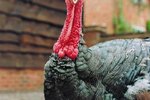
Determining the sex of a baby turkeys, or poults, can be challenging. It depends on the breed of turkey you have. One method, vent sexing, takes a keen eye and lots of practice. Some breeds tell their gender through natural or genetically altered feather color. Some farmers may tell you that egg shape lets you know what gender you will have, but this method is not accurate.
Up Close and Personal
Vent sexing began in the 1920s as a method of determining gender in chicks and poults. This method examines the vent, or opening, to examine the developing sexual organs. Typically, females have concave or flat centers while males have round bumps. This method takes time and training, and skilled vent sexers have only a 90 percent to 95 percent success rate. Untrained sexers are lucky to have a 60 percent to 70 percent success rate.
Feathers Tell the Story
Depending on the breed of turkey, feather color can identify females and males. In commercial turkeys, colored feathers were genetically removed in the 1960s to avoid the black pigment left behind when feathers were plucked. A new genetic alteration allows color to develop in poults, but the coloring changes to white as they get older. In these birds, females have brown down feathers, while males have black. Another feather method looks at the feather buds right after birth. In females, the primary wing feather stubs will display opened plumage. In males, the tips are white and toothpicklike.
References
Photo Credits
-
Photos.com/AbleStock.com/Getty Images
Writer Bio
Deborah Lundin is a professional writer with more than 20 years of experience in the medical field and as a small business owner. She studied medical science and sociology at Northern Illinois University. Her passions and interests include fitness, health, healthy eating, children and pets.



